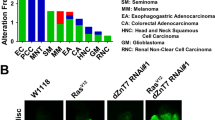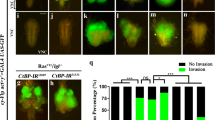Abstract
Atypical protein kinase C (aPKC) and Lethal giant larvae (Lgl) regulate apical–basal polarity in Drosophila and mammalian epithelia. At the apical domain, aPKC phosphorylates and displaces Lgl that, in turn, maintains aPKC inactive at the basolateral region. The mutual exclusion of these two proteins seems to be crucial for the correct epithelial structure and function. Here we show that a cortical aPKC loading induces Lgl cytoplasmic release and massive overgrowth in Drosophila imaginal epithelia, whereas a cytoplasmic expression does not alter proliferation and epithelial overall structure. As two aPKC isoforms (ι and ζ) exist in humans and we previously showed that Drosophila Lgl is the functional homologue of the Human giant larvae-1 (Hugl-1) protein, we argued if the same mechanism of mutual exclusion could be impaired in human epithelial disorders and investigated aPKCι, aPKCζ and Hugl-1 localization in cancers deriving from ovarian surface epithelium. Both in mucinous and serous histotypes, aPKCζ showed an apical-to-cortical redistribution and Hugl-1 showed a membrane-to-cytoplasm release, perfectly recapitulating the Drosophila model. Although several recent works support a causative role for aPKCι overexpression in human carcinomas, our results suggest a key role for aPKCζ in apical–basal polarity loosening, a mechanism that seems to be driven by changes in protein localization rather than in protein abundance.
This is a preview of subscription content, access via your institution
Access options
Subscribe to this journal
Receive 50 print issues and online access
$259.00 per year
only $5.18 per issue
Buy this article
- Purchase on Springer Link
- Instant access to full article PDF
Prices may be subject to local taxes which are calculated during checkout




Similar content being viewed by others
References
Auersperg N, Wong AST, Choi K-C, Kang SK, Leung PC . (2001). Ovarian surface epithelium: biology, endocrinology, and pathology. Endocr Rev 22: 255–288.
Bell DA . (2005). Origins and molecular pathology of ovarian cancer. Modern Pathol 18: S19–S32.
Betschinger J, Eisenhaber F, Knoblich JA . (2005). Phosphorylation-induced autoinhibition regulates the cytoskeletal protein Lethal (2) giant larvae. Curr Biol 15: 276–282.
Bilder D . (2004). Epithelial polarity and proliferation control: links from the Drosophila neoplastic tumor suppressors. Genes Dev 18: 1909–1925.
Bilder D, Li M, Perrimon N . (2000). Cooperative regulation of cell polarity and growth by Drosophila tumor suppressors. Science 289: 113–116.
Brand AH, Perrimon N . (1993). Targeted gene expression as a means of altering cell fates and generating dominant phenotypes. Development 118: 401–415.
Bryant PJ, Schmidt O . (1990). The genetic control of cell proliferation in Drosophila imaginal discs. J Cell Sci Suppl 13: 169–189.
Chalmers AD, Pambos M, Mason J, Lang S, Wylie C, Papalopulu N . (2004). aPKC, Crumbs3 and Lgl2 control apicobasal polarity in early vertebrate development. Development 132: 977–986.
Christiansen JJ, Rajasekaran AK . (2006). Reassessing epithelial to mesenchymal transition as a prerequisite for carcinoma invasion and metastasis. Cancer Res 66: 8319–8326.
Eder AM, Sui X, Rosen DG, Nolden LK, Cheng KW, Lahad JP et al. (2005). Atypical PKCι contributes to poor prognosis through loss of apical–basal polarity and cyclin E overexpression in ovarian cancer. PNAS 102: 12519–12524.
Filip S, Mokry J, English D . (2006). Stem cell plasticity and carcinogenesis. Neoplasma 53: 87–91.
Gibson MC, Patel AB, Nagpal R, Perrimon N . (2006). The emergence of geometric order in proliferating metazoan epithelia. Nature 442: 1038–1041.
Grifoni D, Garoia F, Schimanski CC, Schmitz G, Laurenti E, Galle PR et al. (2004). The human protein Hugl-1 substitutes for Drosophila lethal giant larvae tumour suppressor function in vivo. Oncogene 23: 8688–8694.
Harris TJC, Peifer M . (2004). Adherens junction-dependent and -independent steps in the establishment of epithelial cell polarity in Drosophila. J Cell Biol 167: 135–147.
Humbert P, Russell S, Richardson H . (2003). Dlg, Scribble and Lgl in cell polarity, cell proliferation and cancer. BioEssays 25: 542–553.
Hutterer A, Betschinger J, Petronczki M, Knoblich JA . (2004). Sequential roles of Cdc42, Par-6, aPKC, and Lgl during Drosophila embryogenesis. Dev Cell 6: 845–854.
Katabuchi H, Okamura H . (2003). Cell biology of human ovarian surface epithelial cells and ovarian carcinogenesis. Med Electron Microsc 36: 74–86.
Kovac J, Oster H, Leitges M . (2007). Expression of the atypical protein kinase C (aPKC) isoforms ι/λ and ζ during mouse embryogenesis. Gene Expr Patterns 7: 187–196.
Kuphal S, Wallner S, Schimanski CC, Bataille F, Hofer P, Strand S et al. (2006). Expression of Hugl-1 is strongly reduced in malignant melanoma. Oncogene 5: 103–110.
Lee C-Y, Robinson KJ, Doe CQ . (2006). Lgl, Pins and aPKC regulate neuroblast self-renewal versus differentiation. Nature 439: 594–598.
Manfruelli P, Arquier N, Hanratty WP, Sémériva M . (1996). The tumor suppressor gene, lethal(2)giant larvae (1(2)g1), is required for cell shape change of epithelial cells during Drosophila development. Development 122: 2283–2294.
Naora H, Montell DJ . (2005). Ovarian cancer metastasis: integrating insights from disparate model organisms. Nat Rev Cancer 5: 355–366.
Nelson WJ . (2003). Adaptation of core mechanisms to generate cell polarity. Nature 422: 766–774.
Okamura H, Katabuchi H, Nitta M, Ohtake H . (2006). Structural changes and cell properties of human ovarian surface epithelium in ovarian pathophysiology. Microsc Res Techniq 69: 469–481.
Ong A, Maines-Bandiera SL, Roskelley CD, Auersperg N . (2000). An ovarian adenocarcinoma line derived from SV40/E-cadherin-transfected normal human ovarian surface epithelium. Int J Cancer 85: 430–437.
Pilot F, Lecuit T . (2005). Compartmentalized morphogenesis in epithelia: from cell to tissue shape. Dev Dyn 232: 685–694.
Plant PJ, Fawcett JP, Lin DCC, Holdorf AD, Binns K, Kulkarni S et al. (2003). A polarity complex of mPar-6 and atypical PKC binds, phosphorylates and regulates mammalian Lgl. Nat Cell Biol 5: 301–308.
Polyak K, Hahn WC . (2006). Roots and stems: stem cells in cancer. Nat Med 11: 296–300.
Queenan AM, Ghabrial A, Schupbach T . (1997). Ectopic activation of torpedo/Egfr, a Drosophila receptor tyrosine kinase, dorsalizes both the eggshell and the embryo. Development 124: 3871–3880.
Regala RP, Weems C, Jamieson L, Khoor A, Edell ES, Lohse CM et al. (2005). Atypical protein kinase Cι is an oncogene in human non-small cell lung cancer. Cancer Res 65: 8905–8911.
Rolls MM, Albertson R, Shih H-P, Lee C-Y, Doe CQ . (2003). Drosophila aPKC regulates cell polarity and cell proliferation in neuroblasts and epithelia. J Cell Biol 163: 1089–1098.
Sarrío D, Moreno-Bueno G, Sánchez-Estévez C, Bañón-Rodríguez I, Hernández-Cortés G, Hardisson D et al. (2006). Expression of cadherins and catenins correlates with distinct histologic types of ovarian carcinomas. Hum Pathol 37: 1042–1049.
Schimanski CC, Schmitz G, Kashyap A, Bosserhoff AK, Bataille F, Schafer SC et al. (2005). Reduced expression of Hugl-1, the human homologue of Drosophila tumour suppressor gene lgl, contributes to progression of colorectal cancer. Oncogene 24: 3100–3109.
Scott A, McCluggage WG . (2006). Current concepts in ovarian epithelial tumorigenesis: correlation between morphological and molecular data. Histol Histopathol 21: 81–92.
Shin K, Fogg VC, Margolis B . (2006). Tight junctions and cell polarity. Annu Rev Cell Dev Biol 22: 207–235.
Siemens CH, Auersperg N . (1988). Serial propagation of human ovarian surface epithelium in tissue culture. J Cell Physiol 134: 347–356.
Sundfeldt K . (2003). Cell-cell adhesion in the normal ovary and ovarian tumors of epithelial origin; an exception to the rule. Mol Cell Endocrinol 202: 89–96.
Suzuki A, Ohno S . (2006). The PAR-aPKC system: lessons in polarity. J Cell Sci 119: 979–987.
Suzuki A, Yamanaka T, Hirose T, Manabe N, Mizuno K, Shimizu M et al. (2001). Atypical protein kinase C is involved in the evolutionarily conserved PAR protein complex and plays a critical role in establishing epithelia-specific junctional structures. J Cell Biol 152: 1183–1196.
Thiery JP . (2002). Epithelial-mesenchymal transitions in tumour progression. Nat Rev Cancer 2: 442–454.
Vanderhyden BC, Shaw TJ, Ethier J-F . (2003). Animal models of ovarian cancers. RB&E 1: 67.
Weinkove D, Leevers SJ . (2000). The genetic control of organ growth: insights from Drosophila. Curr Opin Genet Dev 10: 75–80.
Yamanaka T, Horikoshi Y, Izumi N, Suzuki A, Mizuno K, Ohno S . (2006). Lgl mediates apical domain disassembly by suppressing the PAR-3-aPKC-PAR-6 complex to orient apical membrane polarity. J Cell Sci 119: 2107–2118.
Yamanaka T, Horikoshi Y, Sugiyama Y, Ishiyama C, Suzuki A, Hirose T et al. (2003). Mammalian Lgl forms a protein complex with PAR-6 and aPKC independently of PAR-3 to regulate epithelial cell polarity. Curr Biol 13: 734–743.
Acknowledgements
We thank all members of the ‘TNT Group’ for fraternal support, Raffaella Buda and Guglielmo Caruso for tumor samples and Chris Doe for UAS-aPKC strains. FG is supported by a fellowship from ‘Fondazione Cassa di Risparmio in Bologna’, FP is supported by a fellowship from the PhD program in ‘Cell Biology and Physiology’ of the University of Bologna.
Author information
Authors and Affiliations
Corresponding author
Rights and permissions
About this article
Cite this article
Grifoni, D., Garoia, F., Bellosta, P. et al. aPKCζ cortical loading is associated with Lgl cytoplasmic release and tumor growth in Drosophila and human epithelia. Oncogene 26, 5960–5965 (2007). https://doi.org/10.1038/sj.onc.1210389
Received:
Revised:
Accepted:
Published:
Issue Date:
DOI: https://doi.org/10.1038/sj.onc.1210389
Keywords
This article is cited by
-
Characterization of MicroRNA-200 pathway in ovarian cancer and serous intraepithelial carcinoma of fallopian tube
BMC Cancer (2017)
-
Human Cancer Cells Signal Their Competitive Fitness Through MYC Activity
Scientific Reports (2017)
-
Multiple strategies of oxygen supply in Drosophila malignancies identify tracheogenesis as a novel cancer hallmark
Scientific Reports (2015)
-
Rewiring cell polarity signaling in cancer
Oncogene (2015)
-
Hugl-1 inhibits glioma cell growth in intracranial model
Journal of Neuro-Oncology (2015)



